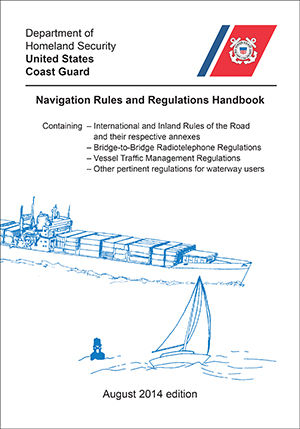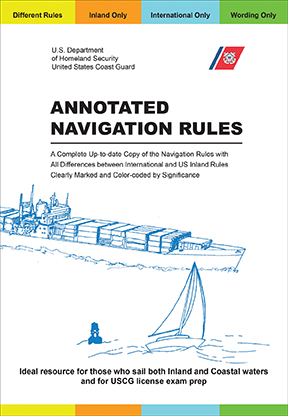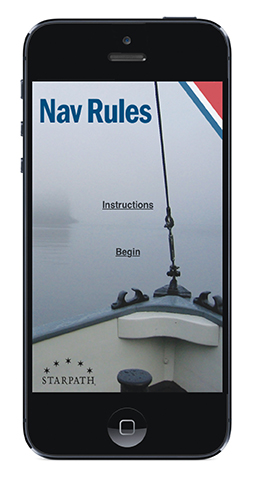Understanding the most important book in navigation (published November 2014)Recent maritime news brings us back to the Navigation Rules. We tend to think of these Rules as the guideline to preventing collisions between vessels—in fact, the document is a product of the 1972 Convention on the International Regulations for Preventing Collisions at Sea (COLREGS). We have long proclaimed, however, that the book is intended to be much more. Namely, the guide to preventing collisions with anything!
If you carefully scan the text, you will find there is only one reference in the entire book that refers to collisions with anything other than a vessel. This is in Rule 6b that specifies holding a safe speed to prevent collisions with ice. A very simple, single sentence, but one that I have always felt is packed with implications.
Collisions with things that are not vessels, especially those fixed to the ground and above the surface, are legally called allisions to distinguish them from collisions between vessels. They call for a different type of legal analysis. If you hit a dock, it is usually not the dock’s fault. But what is not so well appreciated, as it should be, is that the Navigation Rules are still the governing legal document and guideline to prevent hitting this dock, or other fixed objects like an island or a reef—sort of like ice.
The key rules that come into play for avoiding navigation accidents of any kind are Rule 2 on responsibility, Rule 5 on proper watch and Rule 6 on safe speed. Everyone involved with boating might want to know Rule 2a by heart: “Nothing in these Rules shall exonerate any vessel, or the owner, master or crew thereof, from the consequences of any neglect to comply with these Rules or of the neglect of any precaution which may be required by the ordinary practice of seamen, or by the special circumstances of the case.” [emphasis added].
The first part reminds us that anyone who has anything to do with the boat is exposed to liability. The second part sets the bar, but not very high. This rule does not require special knowledge or training; it does not even require being particularly smart in situations, but it does require an ordinary level of knowledge and behavior. Knowing the Rules is important and must be obeyed as ordinary knowledge.
A recent court case in the UK brings these points back into focus (www.gov.uk/government/news/master-fined-after-wind-farm-collision-off-norfolk-coast). The master of a wind farm support vessel was fined the equivalent of about $5,000 for hitting a wind turbine tower head on at 12 knots causing much damage to the boat with some injuries. The judge specifically cited the violation of Rule 5, not having proper look out by all appropriate means available. Rather than using radar, GPS and charts, he was navigating in bad weather by the private lights on the towers themselves, and he hit the one whose lights had failed. The Rules enter into all court cases like this, but it is not often we see in public transcriptions such a specific reference to a specific rule violation as the cause of the accident. If we could see more of these, it would be a benefit to mariners.

The Rules are also in the news because the USCG has issued a new edition after many years—it even has a new name. It is now called Navigation Rules and Regulations Handbook. The cover looks the same, other than the title, and the International and U.S. Inland Rules included are the same as in the earlier edition, but with the many past typos corrected. The main change is to include more of the regulations on U.S. inland waters, and indeed a few changes to these regulations do appear. There is an implication that the book might be published more often than in the past, at least as a PDF, but this is not certain. The new book can be downloaded at navcen.uscg.gov/pdf/navRules/Handbook/CG_NAV_RULES_20140910.pdf.
This brings to mind a related issue in U.S. government navigation publications in general. For some years now the U.S. Gov. Printing Office has stopped printing several key navigation publications. The responsible agencies have instead offered the documents to the public as PDFs and also gave several private companies the right to publish the books in print. But the agencies may not, it seems, have placed very tight restrictions on what they print. We are left to wonder about the content in some cases, because the very titles of these publications have not been respected in the third party printing. A case in point is the NOAA Tidal Current Tables. We have seen these online and in bookstores named simply Current Tables. Inside the book they say they meet USCG requirements, but we do not know this till we get the book in hand. Once a new title is used, we do not know how much important auxiliary data from the original is actually included.
The same has already happened with the new Nav Rules edition. We see online and in book stores presumably this new edition with the identical title as the previous edition, now just labeled as “August 2014 edition.” I am certainly not defending the new official title, USCG August 2014 Navigation Rules and Regulations Handbook, and especially not its catchy new subtitle: Containing International and Inland Rules of the Road and their respective annexes, Bridge-to-Bridge Radiotelephone Regulations, Vessel Traffic Management Regulations, and Other pertinent regulations for waterway users, but we do need publication standards if we want libraries and international book numbering systems (ISBN) to keep working. Maybe a librarian or book buyer will latch onto this issue and help us make the point.
It is interesting that the USCG has now used the phrase “Rules of the Road.” The term is well known, but it has not been used much in training since it does not appear in the COLREGS governing the Navigation Rules since the mid 1900s. A notable exception is one of the best books available on the Rules called Farwell’s Rules of the Nautical Road, now edited by University of Washington professor Craig Allen—the original author, Raymond Farwell, was also on the faculty of University of Washington, our neighbor here in Seattle.
The maritime use of this phrase comes from an 1867 pamphlet called The Rule of the Road at Sea by Thomas Gray (the 1884 edition is online). It was a popular publication for many years because it expressed the Rules in terms of rhymes that were easy to remember. For example:
When both side-lights you see ahead,
Port your helm* and show your RED.
and
Both in safety and in doubt
Always keep a good look-out;
In danger, with no room to turn,
Ease her, Stop her, Go astern.
We still use such things in the classroom today, such as “Red over red, the Captain is dead.”
A first flip through the Nav Rules book might be discouraging, but there is much duplication and many parts that will never be used by most mariners. The basics are the Lights and Sounds and the Steering and Sailing Rules (sometimes called right of way, but that is too general a phrase. It does not appear in the Rules).
 Navigation lights and sound signals are important, as they identify vessel types and maneuvers we must respond to, but they are straightforward and can be learned with homemade flash cards. We gain most of our safety and confidence from knowing the Steering and Sailing Rules, which are just 15 short pages (Rules 4 to 19). One might start by just extracting those pages as a PDF to load into a smartphone so we can study them in those random (and sometimes scheduled) times we are sitting around with a few minutes to spare with our phone in our hand. We have such a file for this purpose at starpath.com/navpubs. You can download it then email it to your phone. Learn these International Rules first, then check out our text (print or ebook) called Annotated Navigation Rules that color codes and highlights all the differences between International and U.S. Inland Rules. The iOS app called NavRules (navrulesmobile.com) is also a convenient way to master the Rules by answering USCG exam questions tied to each Rule.
Navigation lights and sound signals are important, as they identify vessel types and maneuvers we must respond to, but they are straightforward and can be learned with homemade flash cards. We gain most of our safety and confidence from knowing the Steering and Sailing Rules, which are just 15 short pages (Rules 4 to 19). One might start by just extracting those pages as a PDF to load into a smartphone so we can study them in those random (and sometimes scheduled) times we are sitting around with a few minutes to spare with our phone in our hand. We have such a file for this purpose at starpath.com/navpubs. You can download it then email it to your phone. Learn these International Rules first, then check out our text (print or ebook) called Annotated Navigation Rules that color codes and highlights all the differences between International and U.S. Inland Rules. The iOS app called NavRules (navrulesmobile.com) is also a convenient way to master the Rules by answering USCG exam questions tied to each Rule.
Most Rules are easy to apply. More subtle questions involve what to do when the other vessel does not obey the Rules and how to decide when to react. Say you are under sail and a crossing powerboat is not giving way and you are at risk of collision. You are supposed to hold course and speed during this encounter, but for how long, and then what do you do? This is covered in Rules 8, 16 and 17.
The key concept is close quarters, which the courts have been defined as that space around you that you must protect for the safety of your vessel in the present circumstances. It means the separation between you and the approaching vessel that you must have in order to safely maneuver your vessel to prevent a collision, regardless of what the other vessel might do, suddenly and unexpectedly.
As long as you have this space, you are safe and you do not have to let any other vessel into that space for any reason. The size and shape of this space varies with individual vessels and with the circumstances. Traveling slowly in a narrow channel it could be yards. Interacting with fast ships at sea it would be measured in miles. The short answer then is, you maneuver before close quarters develops, but read the Rules for the full story.
Another subtlety that you will be very happy to understand by learning the Rules is what you should do when in pea soup fog you see a radar target headed straight toward you. What you do is covered very specifically in Rule 19d. The key point here that is not often fully appreciated is that there is no right of way in the fog. When you are interacting to avoid collision by radar alone, there is no distinction between ship and sailboat, no such thing as a stand-on vessel, nor a give-way vessel. Both vessels must maneuver in all circumstances, and indeed they must maneuver earlier than they would if they were in sight of each other. But I do not want to give away all the details. Please read the Rule.
The same Rule covers what you do without radar in pea soup fog if you hear the fog signal of a vessel apparently forward of the beam. Again, we need to check the Rule, but we already know part of the answer: “Ease her, Stop her, Go astern.”
Study of the Rules is a rewarding pastime, practical and captivating. They constitute a remarkable document with an immense assigned task—preventing collisions between a vast array of vessels in a vast array of circumstances: vessels barely visible at 100 yards to vessels the size of horizontal skyscrapers; drifting without power or traveling at 30 knots or more; following unmarked lanes or crisscrossing open waters offering nothing more than an educated guess as to their intended course; in all conditions of weather, clear or fog, calm or storm; and often with no common language between their drivers.
 Despite this enormous assignment, they do the job. And if we need further proof of that or why the Navigation Rules and Regulations Handbook is the new most important book in navigation, note this: Essentially every collision between two vessels involves the violation of at least one of the Navigation Rules by both of the vessels involved. Thus, from a purely statistical point of view, if you know and obey the Rules, it is very unlikely that you will ever be involved in a collision.
Despite this enormous assignment, they do the job. And if we need further proof of that or why the Navigation Rules and Regulations Handbook is the new most important book in navigation, note this: Essentially every collision between two vessels involves the violation of at least one of the Navigation Rules by both of the vessels involved. Thus, from a purely statistical point of view, if you know and obey the Rules, it is very unlikely that you will ever be involved in a collision.
David Burch is the director of Starpath School of Navigation, which offers online courses in marine navigation and weather at www.starpath.com. He has written eight books on navigation and received the Institute of Navigation’s Superior Achievement Award for outstanding performance as a practicing navigator.

















